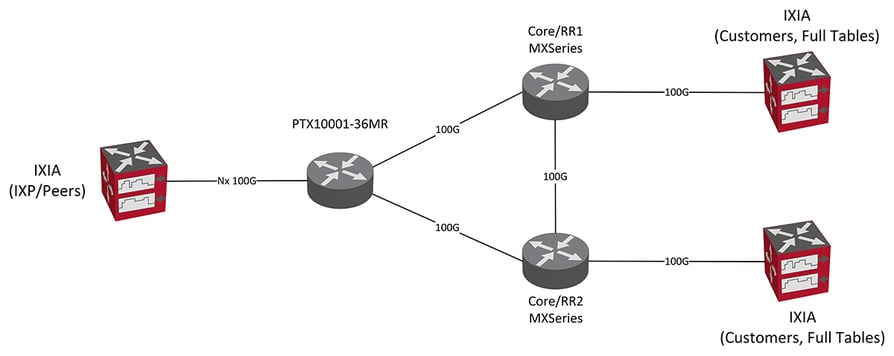 Juniper Networks PTX Series Routers were previously designed to be used as MPLS-P devices in large tier 1 networks. With the new generation, the PTX series now includes devices that can be appealing for different use cases and utilization in smaller networks as well. The new PTX systems now run Junos Evolved, a modernized variant of the established Junos OS.
Juniper Networks PTX Series Routers were previously designed to be used as MPLS-P devices in large tier 1 networks. With the new generation, the PTX series now includes devices that can be appealing for different use cases and utilization in smaller networks as well. The new PTX systems now run Junos Evolved, a modernized variant of the established Junos OS.
All in all, for the Xantaro team a reason to test the new PTX10001-36MR and take a closer look at the vendor’s promises “beyond the data sheets”!
Juniper Networks PTX Series Packet Transport Routers – from the beginnings till now
Juniper Networks PTX Series routers were originally introduced for the role of Core routers in IP/MPLS networks dedicated to being MPLS-P nodes in e.g., BGP free networks. The devices were designed to provide very high port speeds and allow enormous throughputs and high port densities. A performance that came at a price for quite a long time though!
The scaling e.g., with regards to the number of routes that could be kept in the Forward Information Base (FIB) was limited. Focused on MPLS forwarding, the PTX routers for the time being were only able to handle low 5-digit number of routes. Most of the advanced functions needed at the network edge were not provided.
Over time, however, the PTX series grew with regards to both performance and port density as well as in versatility. The amount of scale for the data plane increased rapidly to allow for millions of entries as of today. During this evolution the PTX gained new features enabling the system to handle a lot of additional roles throughout the network, including the network edge.
New Routers, new NOS: PTX & Junos Evolved
While the initial PTX Series devices were chassis-based systems that could easily fill a whole network rack, the PTX Series now also offers small form factor devices offering the same data-plane scale and functionality as their larger siblings without compromising on terms of bandwidth per size.
As one of the vendor’s first routers, the new PTX systems are already running Junos Evolved, the new cloud-optimized Network Operating System (NOS) from Juniper Networks. Junos Evolved – in short Evo – was rebuild around the paradigm of a central state database and efficient communication between process to allow for higher scalability.
Currently Junos Evo is not yet available for all Juniper systems and not yet covering 100% of all use cases the regular Junos version does for other platforms today. However, new features are constantly being added, making the PTX series the perfect set of devices to be run with Junos Evo as it is constantly evolving and receiving new features as well.
PTX as Internet-scale Peering / Edge Router in a modern provider network
Not every network requires a 16 slots PTX10016 with up to 576 x 400GE ports or 2304 x 100GE ports. Accordingly, sometimes a more appropriate alternative could be, for example, the PTX10001-36MR, a compact 1 RU router with up to 10.8Tbit/s forwarding capacity.
Juniper PTX10001-36MR
PTX10001-36MR offers up to 24 x 400GE plus 12 x 100GE or optionally up to 108 x 100GE of interfaces while being able to also support slower speeds like 40GE, 10GE as well as 200GE. As mentioned above PTX10001 routers provides high scalability by being able to hold up to 2M entries in its FIB. This is more than enough to accommodate for IPv4 and IPV6 full tables natively and still have room to grow over the next years.
But can the PTX10001 handle being a Peering/Edge Router in a modern Service Provider Network?
Juniper Networks PTX10001-36MR test setup in the XT3Lab
Inspired by real world use cases from our customers, we put the PTX10001-36MR – as a representative of the new PTX generation – through a series of tests to verify whether it can actually master all the challenges of a modern Peering Edge.
- First the PTX was connected to a core network simulated by two Juniper MX Series Routers running an IP/MPLS based network on LDP and RSVP. It received four full tables (both IPv4 and IPv6) from a pair of route reflectors and extracted about 1M usable IPv4 and 200k IPv6 routes into its FIB.
- On top of that base load, we simulated the PTX being connected to an IXP LAN by emulating a hundred IPv4 and IPv6 peers each sending 100 routes each.
- Of course, all the basic features you would expect for a peering box were enabled in parallel. This includes uRPF, ingress ACLs, the option to off-ramp traffic for mitigation or detailed analysis in case of network attacks, as well as a handful of IP/MPLS L3VPNs.
- Finally, we loaded the network with a couple hundred gigabit/s of traffic generated by an IXIA load generator meshed between the various end points so that all routes of the full tables plus peering, customer and L3VPN routes will receive some part of the overall traffic load.
Juniper PTX10001-36MR Test-Szenario im XT3Lab
The first test step was to verify a couple of common attack mitigate scenarios like RTBH, sRTBH and traffic off-ramping (using an IP/MPLS L3VPN in this case).
The following tests focussed on convergence in various failure scenarios. This includes failures of single links or complete nodes in the tested topology as well as direct and indirect failures of BGP sessions and the resulting need to relearn routes, all of this while still handling the traffic as described above.
The result: Yes, it can!
After all this tests we can confidently say that the PTX10001-36MR certainly can be used as a peering router for typical scenarios!
The system handled both the mitigation and all failure scenarios very well and typically converged in under a second. The packet loss measured by the IXIA system was less than 1000ms for all directions in these cases.
Furthermore, we also briefly tested the PTX10001 as an MPLS-P node, although it was not surprising that it also handles this pretty well.
Currently not yet supported to full extend by Junos Evo are some of the more “legacy” MPLS services like VPLS. However, with EVPN a more than capable alternative is covered. Accordingly, testing on L2-MPLS services such as L2VPN or EVPN are on the list and will follow soon!
Experience Juniper Networks latest technology live and test it individually
For specific use cases and in the context of network-specific configurations, both the Junos Evo software and the new PTX systems should be intensively qualified before being implemented in a network.
Our XT³Lab environment in Frankfurt, which today can safely be called the largest Juniper Technology and Test Lab in Germany, provides the ideal infrastructure to do so. Equipped with all common solutions from Juniper Networks, the new PTX system including Junos Evolved is also available here for testing any individual scenarios – don’t hesitate to contact us!
Share your opinion with us!
Your perspective counts! Leave a comment on our blog article and let us know what you think.
.png?width=300&height=300&name=Design%20ohne%20Titel%20(7).png)


